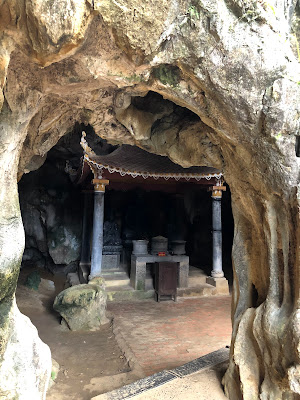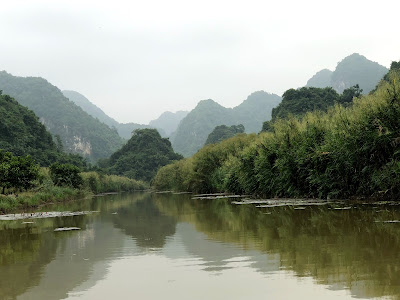 |
| Should I stay or should I leave? This sign was at the entrance to the Bich Dong Pagoda. |
Today we traveled from Puluong to the city of Ninh Binh. We had to take a longer route (about four hours) due to a bridge that had washed out in the recent flooding. Although longer, it was probably a more interesting route due to the fact that a great deal of it was on roads that were often only slightly wider than one lane. These "roads less traveled" took us through a number of villages as we made our way. There were wedding festivals going on in several of them. It seemed as if most of the people of the villages had turned out to celebrate the marriages. There were tables of food and drink and well as plenty of dancing. I told Tony and Ang that we should stop and join them, although I'm pretty sure Beth and I would have been immediately spotted as "wedding crashers".
 |
| Workers harvesting rice near Puluong |
One of the larger roads we traveled on had been constructed on what was known as the Ho Chi Min Trail during the Vietnam War (which over here is appropriately referred to as the American War). During the war this was literally a trail through what was then forests and mountain passes. It ran from Hanoi to Saigon and was used by the North Vietnamese to infiltrate South Vietnam with troops and supplies. It was interesting to reflect on what it must have looked like then and the role it played during the war. Today it's a modern highway running most of the length of the country.
We were told Ninh Binh was a fairly impoverished area of Vietnam for many years due to the fact that rice cannot be grown here. They realized that they had something that was probably far more valuable in the long run, an incredible natural landscape of rivers, limestone mountains and caves, as well as many historical sites. The once sleepy area is now flourishing with travelers spending a few days here or simply making day trips from Hanoi.
We visited the King Dinh and King Le Temples. These were the first rulers to unify the country back in the 10th century. Their efforts were short lived. Shortly after they died infighting for control started among their children. This distraction led to a Chinese invasion which resulted in all the squabbling kids being wiped out and control switching back to China for a period of time. There's a lesson in there to play nice with your siblings and share appropriately.
 |
| Entrance to the King Dinh Temple |
 |
| Inside the King Dinh Temple |
Afterwards we visited the Bich Dong Pagoda. This pagoda was built by two monks in the early 1700's who were intrigued by the area. The pagoda has three temples built into the side of the mountain. They are cleverly named the lower, middle and upper temples, It was a little bit of a climb to get to the upper temple but well worth the effort.
 |
| Outside the lower temple |
 |
| The middle temple |
 |
| The upper temple |
We finished the day being rowed through the rivers and limestone caves that helped this area recently receive recognition as a UNESCO World Natural Heritage site. The caves contained stalactites (mineral deposits hanging from the top of the cave) and stalagmites (mineral deposits rising from the floor of the cave). Without a doubt the most interesting one was a stalagmite that looked like Buddha.
 |
| Our rowboat captain. He rowed with his feet the entire time. |
 |
| Along the river |
 |
| This water buffalo along the shoreline struck a pose as we passed. |
 |
| He was finishing his swim from one side of the river to the other |
 |
| A small colony of bats inside one of the caves |
 |
| OK, it's not a great picture and the spotlight doesn't help. Believe me he does look like Buddha |


